地產新聞及評論
本部分旨在提供香港及環球地產市場之最新消息及趨勢。我們專業的評論和意見,助您緊貼各地房地產市場脈搏。
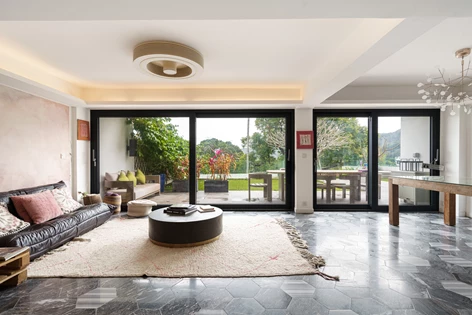
OKAY.COM筍盤推介:西貢相思灣附連私家花園 3房山海雙景地下複式
西貢區居住密度較低,是嚮往親親大自然理想居所。今日為大家介紹相思灣下複式村屋,建築面積1,400方呎,3房2浴設計,內櫳已全面翻新,富有設計感,外連私家花園,日日望山海靚景。西貢相思灣鄰近清水灣道,住客可以自駕至將軍澳僅需約10至15分鐘,區內有多個商場,方便住戶添購生活所需。此外,項目毗鄰龍蝦灣,可隨時前往遊玩獨木舟及直立板等水上活動。建築面積1,400方呎今日參觀相思灣村屋放盤,屬下複式設計,提供1個露天車位。放盤地下主要為客飯廳及廚房,整個空間屬開放式格局,流暢銜接室內與戶外環境。裝潢方面,屋主已全面翻新,裝潢以家庭生活為核心,配以精心傢俬設計,同時透過巧妙的收納規劃創造充裕空間。廳堂設落地玻璃連接特大花園,花園部分空間鋪設人造草皮,亦擺放木餐桌及配餐椅等。廚房設置齊全烹飪設備,亦提
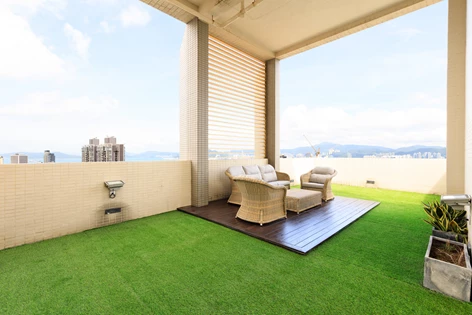
OKAY.COM筍盤推介:西營盤 匯賢居 巨型廳堂高雅柔和
坐落西營盤高街的匯賢居,位處港島中西區名校網內,鄰近中環商業區,屬實力家庭客的置業目標。今日帶大家走訪極高層特色單位,實用面積1,183方呎,3房2浴設計,客廳配有落地玻璃窗,並連私家天台,盡覽維港海景,視野遼闊舒適。馬上參觀市場少有放盤的匯賢居連天台特色單位,業主曾自住此單位,每個細節均展現極致講究的匠心設計。走入放盤,即感受到單位樓底之高,巨型廳堂設計簡約而高雅,鋪上木質地板,搭配白色沙發及地毯,增添柔和氛圍。客廳與飯廳配有落地玻璃窗盡覽海港景致、陽台、遙控情境照明及大金冷暖空調。從廳堂外望,可俯瞰城市與海灣景色,窗外便是高樓大廈與藍天白雲。半開放式廚房配備名牌家電,包括洗衣乾衣機、嵌入式咖啡機、洗碗機、微波爐、葡萄酒冷藏櫃,以及帶緩衝閉合功能的高端廚櫃。單位提供3間房,當中主人房設有
OKAY.COM筍盤推介:大潭陽明山莊 環迴賞景 典雅品味寬敞大廳
大潭陽明山莊作為本港地標豪宅之一,屹立於山峰之間,毗鄰大潭郊野公園,四周群山環抱,私隱度極高,向來吸引一眾城中名人擇善而居。是次介紹為陽明山莊一個單位,面積1624方呎,屬3房戶,單位以現代時尚為設計基調,並主打淺色系設計,從設計及布局中流露出典雅品味,以打造新一代豪宅。入屋即可感受到壯麗華貴。融合莊重及優雅雙重氣質。大廳以淺色大理石瓷磚鋪砌地台,配合特色花紋地毯及屋內中式風格傳統家具,以及充滿古典韻味的裝飾品。盡顯住宅清雅含蓄設計風格,巧妙搭配空間色彩、光影效果和裝飾品,共同打造端莊優雅東方式大宅。1624呎3房雙套開則客廳以長形開則,中央位置擺放一張淺色實木製成長形玻璃茶几,配合多組白色系長形布製沙發,配以多扇飄窗,不僅可享受充足室內光線,住戶安坐家中可飽覽室外美景,將壯麗山景盡收眼底
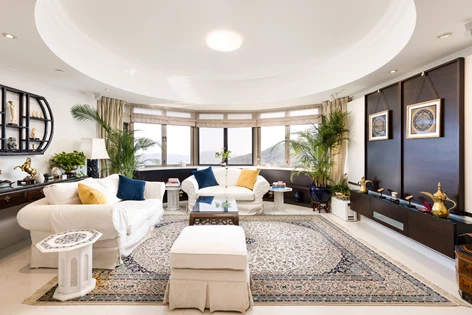
OKAY.COM筍盤推介:跑馬地山村臺屬名校網地段 1,442方呎實用清雅居停
跑馬地單幢盤山村臺,坐落在寧靜住宅地段,數分鐘車程即達熱鬧的銅鑼灣,加上屬名校網區,是實力家庭置業考慮。今日為大家介紹當中的低層,實用面積1,442方呎,3房2浴設計,開則方正實用,全屋多窗光猛,可享區內景致。山村臺位於跑馬地山村臺35至41號,為單罐設計,提供32個單位。單位費用面積由1,232方呎至1,442方呎不等。馬上參觀這個實用面積1,442方呎放盤,進入單位,即見寬敞工整的客飯廳,布置溫馨雅緻,而且,兩廳設有大窗,為一室起通風對流之效。客廳有L形三人座沙發,前方有茶几,小窗台擺放不少綠植點綴,大玻璃窗引充沛陽光,主要望附近樓景。移至飯廳,主角是6人長形木飯桌,天花有特色吊燈,牆身上掛有畫作,美化家居。飯廳旁為廚房,保養良好,設L形廚櫃,提供基本煮食設備,並連接實用的雜物間。3房

OKAY.COM筍盤推介:九龍塘美景閣 優雅空間 庭院天台觀星望月
九龍塘一带豪宅屋苑林立,是本港著名低密度住宅地段之一,是次介紹的美景閣一個頂層特色單位,是市場罕有特色單位放盤,大宅面積1094方呎,屬3房套單位,最大賣點是連私家天台,可將生活延至戶外。甫入屋內,即見整潔明亮大廳,整體空間感十足,面積寬敞實用,廳內更外接私人露台,設長形落地玻璃門,大大提升室內採光度,搭配淺米色瓷磚地板,襯托白色牆身,以及特色假天花設計,營造出獨特設計,進一步展現優雅家居生活。面積1094呎3房套開則客飯兩廳布局分明,設有大型展示櫃分隔兩廳,亦利用不同設計,為主戶打造安樂窩;當中客廳採用長形布局,廳區位置擺放一組長形棕色沙發,前臨與矮身電視櫃,設有多個抽屜,以方便住戶收納日常用品。客廳另一邊為飯廳,中央放置一張大型圓形雲石餐桌,配以多張棗紅色餐桌椅,既耐用又美觀,經典又不
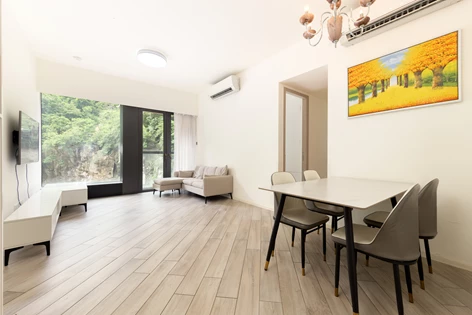
OKAY.COM筍盤推介:北角柏蔚山 淺調時尚風 長形大廳富空間感
北角近年新盤供應罕有,是次介紹區內新晉豪宅屋苑之一的柏蔚山,居住環境靜中帶旺,私隱度極高;該屋苑一個面積823方呎的3房套放盤單位,大宅以現代時尚風格為設計基調,主打淺色系設計,從布局及設計中展現其特色。單位採長方形直廳設計,間隔闊落實用,全屋裝修設計以現代時尚風格為主題,全屋地台由淺色長形木地板鋪砌而成,配以白色系牆身,並利用淺色系家私互相襯托,營造出溫馨愜意氛圍。而大宅內多數採用線條簡單家具,大廳靠牆位置擺放一組大型「L」字形沙發,前迎白色矮身電視櫃,營造現代時尚質感。而毗鄰設有落地玻璃趟門連接露台,可享翠綠景致,環境幽靜之餘,同時大大增加一室採光度,亦將室外綠景引入屋內。823呎3房1套開則客廳毗鄰為飯廳,面積寬闊,布局分隔清晰,設有長形白色雲石餐桌,配四張皮製餐桌椅,鄰近牆身設有入
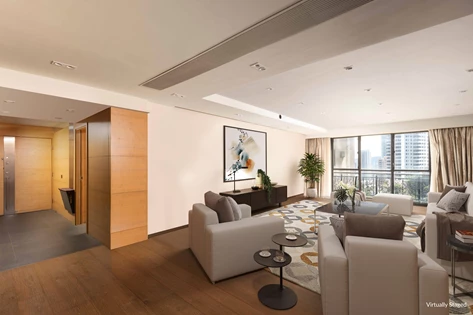
OKAY.COM筍盤推介:中半嘉富麗苑 「框」出風景畫 寬敞巨廳延展空間
中半山為傳統豪宅地段,周邊環境清幽,區內的嘉富麗苑擁優越地理位置,居高臨下俯瞰港島區景色,向來屬城中名人擇居之選。是次介紹屋苑一個複式戶,面積3831方呎:4房3套間隔,單位空間開闊,以木色及白色作主調,配合室外山林美景的獨特視覺美感,營造出私人會所式般奢華生活。單位客廳呈長形,空間寬闊開明,且開則四正,空間感十足。擺放多組灰色沙發,配合木質地板、綠植盆栽及幾何圖案地毯,以凸顯高檔生活的精緻舒適。3831呎4房3套開則客廳的背景牆掛有大型畫作,不但顯露住戶藝術品味,配合整體佈置展現豪宅所具的高貴氛圍。旁邊設置一整排落地玻璃,提高單位亮度之餘,亦有助引景入室,飽覽半山的開闊城景及蔥鬱山景。飯廳放置有具東方色彩的展示櫃,配襯具中國風的花瓶及植物,格調清雅展現住戶生活品味。飯廳亦設有長形8人飯桌

OKAY.COM筍盤推介:薄扶林貝沙灣 環迥海景 長形大廳展現空間
南區指標豪宅屋苑之一的貝沙灣,屋苑背靠山巒、臨海而建,大部分單位可享開揚海景,是次介紹該屋苑2期南岸5座一個高層單位,面積達1320方呎,屬3房1套間隔,大宅可享無遮擋環迴海景,住戶安坐家中可將室外海天一色美景盡收眼簾。大宅位處高層位置,最大賣點是盡享環迴海景,其海景由露台一直延伸至客廳,令全屋每一角落位置均可享受海風與海景,其室內設計自然亦盡花心思,利用不同木系傢俬、書作、藝術漆等配搭得宜,打造愜意山海景居停。附設賞景露台長形大廳寬關實用,空間感極強,單位設計走藝術格調路線,以凸顯屋主品味,利用不深淺色系設計,營造出強烈視覺效果;加上牆身掛設各式藝畫及裝飾品,為家居增添幾分藝術情調。廳區地板及牆身以深淺色系設計,不同區域牆身亦用色不一,視覺上營造強烈對比,在天花吊燈映照之下,更凸顯其型格
OKAY.COM筍盤推介:何文田懿薈 環迴銀幕景 淺調大廳富空間感
何文田作為九龍區傳統豪宅地段,區內地標屋苑之一的懿薈,戶戶擁獨立電梯大堂,私隱度極高;是次介紹一個高層單位,面積1755方呎,為4房2套間隔,大宅以淺色為主調,配以一系列新中式及歐式家具,打造典雅、舒適的新一代豪宅。大宅裝潢以簡約溫暖為主,以白色牆身配以暖木色地板搭配,屋內燈光以暖色燈為主。營造放鬆居住環境。全屋可享180度市景,加上約3.5米特高樓底,使屋內採光度、空間感雙雙倍增。飯廳中央設有長形圓角實木餐桌,供多人同時用餐,桌上備有轉盤,方便共享菜餚。餐桌前方及側旁放有木質儲物櫃,矮身設計亦讓住戶可在上方按自身個人喜好擺放飾物,靈活特顯個人風格。近門口位置則有一張貴妃椅,配合周遭佛像掛畫及擺設,呈現中國古風住宅格調,而上方水晶吊燈則為當中點綴一點西方古典風情。1755呎4房雙套開則客廳


